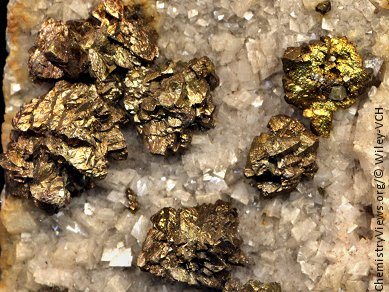In 1546, Georg Agricola named this brass shiny mineral Kupferkies (copper gravel). The name chalcopyrite, which is now common in mineralogy, (Greek chalkos = copper, pyros = fire) was introduced by Henckel in 1725. The mineral has a tetragonal crystal structure at the space group I42d and the composition CuFeS2. The structure can be derived from the sphalerite (α-ZnS), by doubling the unit cell and replacing the zinc ions alternately with Fe2+ and Cu2+.
Chalcopyrite is an important copper ore, which is found in many places; for centuries it was found in Mansfelder Kupferschiefer (copper slate) in Germany, but it is especially common around the Pacific region (South America, USA, Philippines, Papua New Guinea, Australia). The Chuquicamata open-cast mine in Chile is one of the biggest man-made holes in the earth’s crust. Contents of only 0.4 to 2 % of chalcopyrites are considered valuable for mining. The first step is the extraction of copper using the flotation process. This leads to an enrichment of up to 20–30 %. The next steps are often the roasting–smelting process to give copper matte (enrichment to about 60 %), treatment in a converter to give raw copper (> 98 %), and then treatment in an anode furnace (99.5 %). The resulting copper plates are connected as an anode and subjected to electrolysis. Copper with a purity of 99.96 % is deposited on the cathode.
Also of interest are the minor elements in copper ore, these are all “soft” elements, such as Se, Te, As, Sb, Au, Ag, which are obtained as volatile oxides in the exhaust filter during the roasting process or by electrolysis in the anode slurry, which has become a veritable source of the rare elements. Even SO2, which forms during roasting, is converted in a downstream catalytic furnace into SO3 and then into sulfuric acid, which, in turn, is needed in the electrolysis baths or can be sold.
Chalcopyrite together with indium, gallium, and selenium, is used in Copper indium gallium selenide (CIGS) solar cells, and thus there is now increasing interest in it.
The mineral on the picture was found in Dillenburg, Germany.
Picture © Ekkehard Diemann, University of Bielefeld, Germany
- Celestine is the answer to Guess the Mineral (3).
- Chysotile is the answer to Guess the Mineral (2).
- Chrome Diopside is the answer to Guess the Mineral (1).
The next mineral quiz will be published in early December.
The lucky winners of this quiz are D. Wildeboer, UK, and N. Flores, Mexico.




